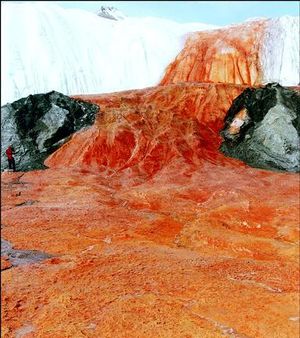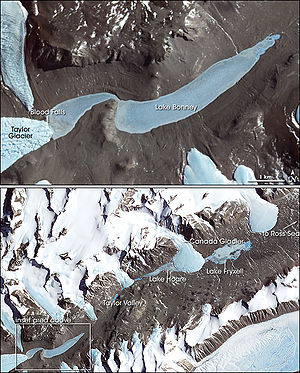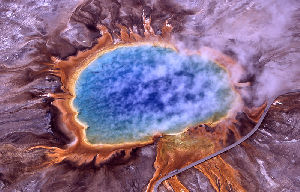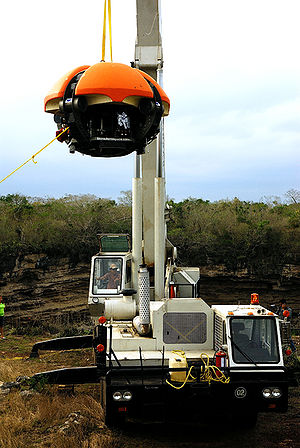Blood Falls, Antarctica


Introduction
Blood Falls, Antarctica is a subglacier outflow that hosts a habitat of microbes. Blood Falls is able to be seen due to the interactions between Taylor Glacier and Lake Bonney. The subglacier outflow, brine has iron in the outflow which results in the outflow appearing to being “blood like,” or a deep red. When the brine flows from the glacier and is exposed to the atmosphere, it becomes oxidized and a red salt cone that comes out of the outflow which is known as Blood Falls. The microbes that survive in Blood Falls are some of the most versatile organisms on the planet as they can survive without oxygen, using iron and sulfate to survive. As these microbes survive without oxygen, an important process for these microbes are that they are evidence of how possible life outside of earth would survive.
Physical Environment
Physical Characteristics
Temperature
The average temperature at the area of Blood Falls is around -20°C, but has a range of temperature of -16° to -21° C. Blood Falls is located at the McMurdo Dry Valleys, which is the largest area of Antarctica as of 2004 to not to be covered with ice. This results in the area of Blood Falls to be very cold, but very dry as well.[5]
Precipitation
The average moisture at the area of Blood Falls is less than six mm of water units. These dry conditions have persisted in the area for about fifteen million years.
pH
The pH found in the habitat was approximately 8.0 or higher with the highest found to be 9.32, which puts the habitat to have a pH that is a base.
Chemical Characteristics
Subglacier Brine
The chemistry of tests conducted of the subglacier brine at Blood Falls varies with the rate of subglacier discharge for normal-discharge from Blood Falls, the water samples showed that there were high concentrations of Iron and no oxygen was detected in the samples. For low-discharge from Blood Falls, the water samples from low-discharge flows collected from Blood Falls had contemporary glacial surface melt. For active-discharge the water samples from active-discharge flows collected from Blood Falls are high in Chloride and sulfate concentrations. Subglacier brine affects how the discharge from Blood Falls look like blood or a red color. The Subglacier brine helps determine how much Iron and oxygen is in various parts of the brine that would determine what microbes can live in these areas.
Biological interactions
Biological Community
The amount of organisms that are important to the Blood Falls community are only represented by a few important phylotypes, how an organism is separated by an organism's evolutionary traits. However, there are many organisms that exist at the Blood Falls community that are not that important nor as rare as the other organism's phylotype.
Bacterial Count
The amount of bacteria per sample in Blood Falls amounted to be more than 300.
Species Richness & Diversity
The Shannon index is a frequently used measure of diversity and therefore provides a relative statistic for comparing studies of different environmental systems. The Shannon Index shows that in Blood Falls the diversity of the species are comparable to measurements from other icy and glaciated environments. However, Blood Falls has twice the diversity compared to pack ice of the Artic and Antarctic. [6]
Key Microorganisms & Microbial processes
Several types of microbes in this habitat are that the microbes are psychrophilic, chemoautotrophically or chemoorganotrophically. The microbes in this habitat survive by harvesting energy from bedrock minerals or the assemblage may grow heterotrophically on ancient marine organics by respiring Fe(III) or SO42_.
Styles of Metabolism
The energy sources that the microbes use in this habitat are chemoautotrophics, chemoorganotrophics and heterotrophs.
Chemoautotrophs
Organisms that are chemoautotrophs are organisms, such as a bacterium that obtains its nourishment through the oxidation of inorganic chemical compounds as opposed to photosynthesis. [7]
Chemoorganotrophs
Organisms that are Chemoorganotrophs utilize organic compounds as their energy source. [8]
Heterotrophs
Organisms that are Heterotrophs are organisms that can’t synthesize its own food and is dependent on complex organic substances for nutrition and survival. [9]
Extremophiles
Organisms that are extremophile is an organism that thrives in and may even require physically or geochemically extreme conditions that are detrimental to the majority of life on Earth. [10]

Energy Sources
The following energy sources have been found to be active in Blood Falls from inorganic compounds, reduced ammonia, reduced Iron, carbon, sulfur compounds, nitrate reduction, sulfate reduction and methanogens has been found to sources of energy.
Psychrophiles
Organisms that are Psychrophiles are organisms that are capable of growth and reproduction in cold temperatures. [11]
Special Adaptations
Chemoautotrophs in Blood Falls, are able to live by respiring iron leached from bedrock with the help of a sulfur catalyst. [12]
Examples of organisms within the group
Thiomicrospira arctica
Betaproteobacteria
Deltaproteobacteria
Gammaproteobacteria
Flavobacterium
Cytophaga Flavobacterium
Psychrobacter
Psychrobacter cryohalolentis
Psychroflexus tropicus
Marinobacter
Marinobacter lipolyticus
Alphaproteobacteria
Caulobacter
Proteobacteria
Bacteroides
Geopsychrobacter electrodiphilus
Desulfocapsa sulfoexigens
Shewanella fridigimarina
Geobacter
Geobacter sulfurreducens
Current Research
Snowball Earth Theory
The discovery of the microbes at Blood Falls, the microbes were found in a place where cold, darkness, and lack of oxygen previously have led scientists to believe nothing could survive at Blood Falls. [13] The discovery of microbes surviving here without using oxygen has given the supporters of the hypothesis of the “Snowball Earth” a key piece of evidence. Stephen Warren is leading an expedition to Antarctica to study the Antarctic ice to study the past climate of the earth. [14]
Life on Other Planetary Bodies
In addition to how the microbes can survive without using Oxygen, research has been started to determine if life can exist outside of Earth under ice, for example at Mars or Europa, a moon of Jupiter. The first step in this research is called Environmentally Non-Disturbing Under-ice Robotic ANtarctiC Explorer (ENDURANCE). This research will help scientists determine what the ocean looks like underneath the Antarctic ice sheet. [15]

Jill A. Mikucki and John C. Priscu Research
Jill A. Mikucki and John C. Priscu conducted a research at Blood Falls that determined the bacterial diversity in Blood Falls the research was designed to be able to validate other researches that determined that the subglacier brine was a host of microbes with using Iron and Sulfate concentrations. The results of this research determined that the brine underneath the ice held a viable ecosystem of microbes that can grow using reduced iron and sulfur compounds. [16]
References
1. Mikucki, J., and Priscu A. ""Bacterial Diversity Associated with Blood Falls, a Subglacial Outflow from the Taylor Glacier, Antarctica". Applied and Environmental Microbiology. 2007. Volume 73, No. 12. p. 4029-4039.
2. Allen, J.. "Blood Falls". NASA. 2008.
3. Mikucki, J., and Priscu A. ""Bacterial Diversity Associated with Blood Falls, a Subglacial Outflow from the Taylor Glacier, Antarctica". Applied and Environmental Microbiology. 2007. Volume 73, No. 12. p. 4029-4039.
4. ["Chemoorganotrophs." The Free Dictionary. 2010. http://encyclopedia.thefreedictionary.com/Chemoorganotrophs (8 April 2010).
5. ["Heterotrophs." The Free Dictionary. 2010. http://encyclopedia.thefreedictionary.com/ Heterotrophs (8 April 2010).
6. ["Extremophile." The Free Dictionary. 2010. http://encyclopedia.thefreedictionary.com/ extremophile (8 April 2010).
7. ["Extremophile." The Free Dictionary. 2010. http://encyclopedia.thefreedictionary.com/ extremophile (8 April 2010).
8. ["Pschrophiless." The Free Dictionary. 2010. http://encyclopedia.thefreedictionary.com/ Psychrophiles (8 April 2010).
9. Mikucki, J., Pearson, A. , Johnston, D., Turchyn, A., Farquhar, J., Schrag, D., Anbar, A., Priscu, J.,and Lee, P."". A Contemporary Microbially Maintained Subglacial Ferrous "Ocean". Science, 2009; 324-397
10. Rejcek, P. "" Snowball Earth Antarctica natural laboratory to test hypothesis that planet was once covered in ice". " ". Antarctic Sun. 2009.
11. Rejcek, P. "" Taking the plungeSpace robot headed for test in Antarctic lake. "". International Journal of Systematic and Evolutionary Microbiology. ". Antarctic Sun. 2008.
12. Rejcek, P. "" Taking the plungeSpace robot headed for test in Antarctic lake. "". International Journal of Systematic and Evolutionary Microbiology. ". Antarctic Sun. 2008.
13. Mikucki, J., and Priscu A. ""Bacterial Diversity Associated with Blood Falls, a Subglacial Outflow from the Taylor Glacier, Antarctica". Applied and Environmental Microbiology. 2007. Volume 73, No. 12. p. 4029-4039.
14. Rejcek, P. "" Taking the plungeSpace robot headed for test in Antarctic lake. "". International Journal of Systematic and Evolutionary Microbiology. ". Antarctic Sun. 2008.
15. Mikucki, J., and Priscu A. ""Bacterial Diversity Associated with Blood Falls, a Subglacial Outflow from the Taylor Glacier, Antarctica". Applied and Environmental Microbiology. 2007. Volume 73, No. 12. p. 4029-4039.
16. Mikucki, J., Foreman, C., Sattler, B., Lyons, W.B., and Priscu J. "Geomicrobiology of Blood Falls: An Iron-Rich Saline Discharge at the Terminus of the Taylor Glacier, Antarctica". Aquatic Geochemistry". 2004. Volumbe 10, No. 3-4. p. 199-220.
Edited by student of Angela Kent at the University of Illinois at Urbana-Champaign.
